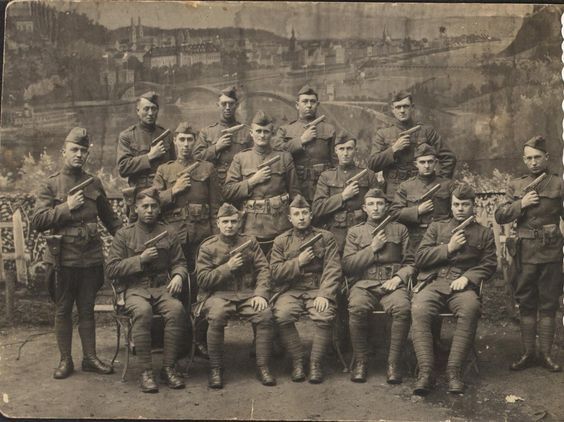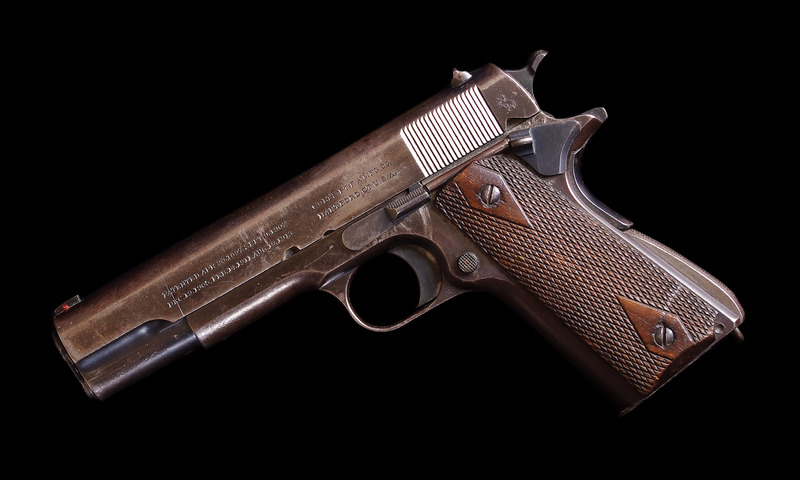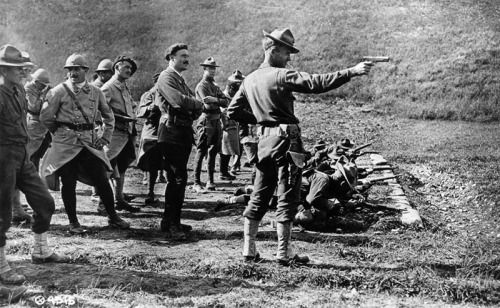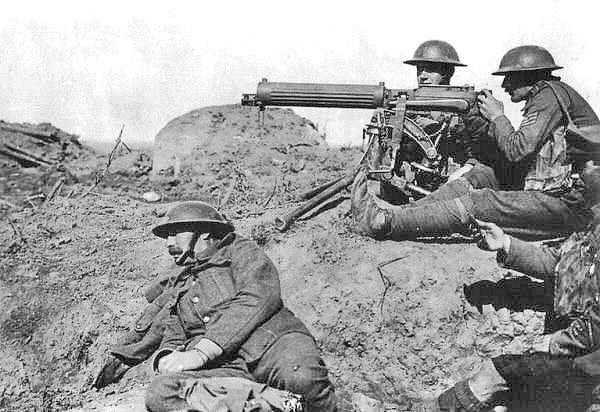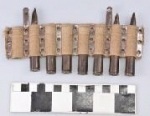2.) Colt Manufactures Firearms for the Great War
Pictured here are just fourteen (one soldier is carrying a different model) of the over two-million Colt M1911 handguns produced by the Colt Manufacturing Company. The handgun became the standard for soldiers of the United States army and navy, and was also adopted by the British navy and air force.
Nearly every soldier depicted in photographs can be seen carrying their Colt 1911 in their holster. As the war progressed, some soldiers used the Colt 1895 during training, preferring to save the 1911 and it's unique anti-locking trigger for actual combat. Only one soldier (top row, second from the right) appears to be holding a pistol that is not a Colt M1911 but a smaller, and perhaps older, pistol.
Historically, soldiers posing together for such an image would have included larger weapons such as a rifle, musket, or bayonette. The fact that soldiers in World War I began to pose with their smaller, lighter handguns speaks to the power and reliability of the Colt M1911, and the trust soldiers placed in these pistols.
This is an original Colt M1911 .45 caliber pistol used in World War I Era before modifications were made in 1924 with the release of the Colt M1911A1
On the top right of the barrel reads "Colt's Pt. F.A.MFG.Co. Hartford, CT, U.S.A" for "Colt's Patented Firearm Manufacturing Company."
Patent dates are engraved on the left side of the barrel, ranging from 1897 to 1913. While the Colt1911 is officially listed as beginning service in 1911, the model originated in the late 1890s prior to undergoing modifications. One can identify this gun as the original model due to the wider trigger, diamond design around the screws on the handle, and the angle at which the loading mechanism rests.
The general idea was to replace revolvers with semi-automatic pistols that were capable of self loading. By 1918, over 425,000 M1911 pistols had been produced and sold, both for government issued models and for the general public.
This pistol shows clear wear and use. showing discoloration/browning of the barrel, and numerous surface scratches throughout. Near the trigger there appears to be the number 13 roughly engraved, as if done by hand, though it's significance is unknown. The trigger also shows signs of age and deterioration, with clear rusting along the grooves.
The Colt M1911 was the standard military issued handgun that was used for training, combat, and daily life in the trenches, and was widely preferred by United States soldiers.
In the book titled The Colt 1911 Pistol Leroy Thompson explains, "In the USA many men who served in World War I, World War II, the Korean War or the Vietnam War used the Colt Government Model and felt comfortable with it" (Thompson). Since many soldiers trained with or owned a personal model of the Colt 1911, it was a reliable weapon, and Colt had the manufacturing capabilities to mass produce, it was a logical choice for the United States government to issue to it’s soldiers.
The Colt M1911 was well known for its power, reliability, and extremely infrequent reports of jamming. Colt claimed that the pistol would average at least six-thousand shots fired without jamming. It did, however, garner a reputation for being somewhat inaccurate, claims which the Colt Company tested and refuted. World War I soldiers, like the one shown in this photograph, often complained during training that the sights were off, prompting Colt to make changes to the M1911 model prior to World War II. Still, the Colt M1911 is often regarded as the most innovative, safe, and reliable pistols ever manufactured, and are still replicated for gun enthusiasts in the twenty-first century.
Soldiers put Connecticut manufactured weapons to use after Colt received their government funding for Vickers machine gun production
While few Vickers machine guns were ready for the start of 1917, many began to reach the front lines by September of that year. During the Battle of Menin Road Bridge, machine guns were used by several infantries in an attempt to clear areas of German troops.
For many soldiers, this would have been the first time firing an actual Vickers machine gun, since training was usually conducted with "dummy" machine guns that didn't actually fire rounds.
While German infantries had machine guns of their own, the Vickers model was considered far superior to the Browning machine gun, and was in high demand to gain tactical advantages.
The production of the Vickers machine gun led to increased factory employment in Hartford and Meriden, Connecticut, and a dramatic stock rise during the war.
Shown in the image to the left are intact, battle used ammunition fragments from the Colt-Vickers M1915 machine gun. While production of the gun was slow at first, many Vickers machine guns reached the lines by late 1917.
According to The United States in the First World War: An Encyclopedia, the belt alone weighed over twenty-two pounds when carrying ammunition.
Setting itself apart from the British Vickers machine gun, the Colt Vickers M1915 used .30-06. caliber rounds, as opposed to the British Vickers which used .303 caliber bullets. Because of this, the Colt Vickers gun and belt were often painted a different color, to differentiate it from the British Model (Wikipedia).
The Colt Vickers and artifacts such as this belt and ammunition fragments are extremely rare, as most Colt Vickers M1915's were destroyed after the war. According to The Standard Catalog of Colt Firearms, "many of those (Vickers) were destroyed after the war. Therefore, original Colt-Vickers ground guns are very rare and quite desireable" (James Tarr). While many gun enthusiasts and gun shows display replicas of this cele
